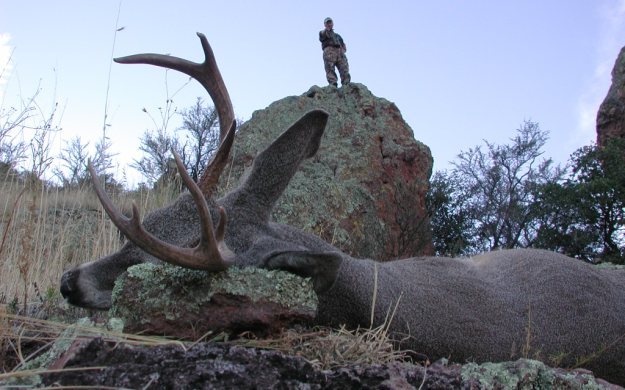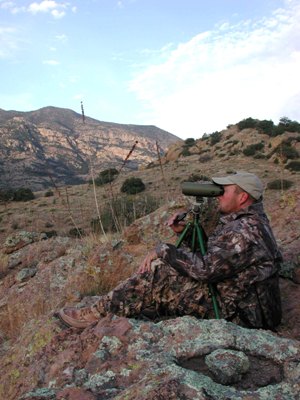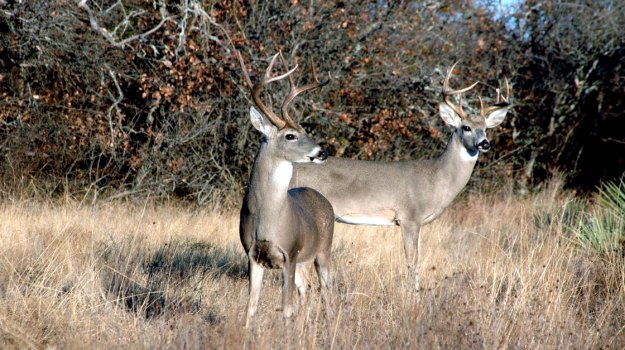
Editor’s Note: Mark Hanson lives in Mesa, Arizona, and has been a Mossy Oak ProStaffer for 7 years. His favorite Mossy Oak camo pattern is Treestand. “I like Treestand because I hunt in a lot of dark timber, high in the mountains, and on land that has been burned. Mossy Oak Treestand fits in every type terrain that I hunt.”
One of my most-memorable Coues deer hunts occurred a few years ago. I had gone in to the mountains, scouted and set up a tree stand at about 6,000 feet elevation. I was about 1/2-hour late leaving the house the morning I had planned to hunt from that stand. The sky was beginning to brighten as I was walking to my stand, parallel to a fence line about 25 yards to my left. As I walked through some live oak trees, I began to hear a strange sound. I stopped and tried to determine what critter would make that kind of sound. After trying to sort out the sound in my mind, I finally decided that the sound resembled a large cat purring. I couldn’t pinpoint exactly where the sound was coming from, but I finally decided that there must be some kind of cat up in a tree. I nocked an arrow because I was uncomfortable.
As the sky lightened up, I saw a gap in the fence 25 yards to my left and spotted a mountain lion standing in that gap looking at me. I started to draw my bow because I didn’t know what would happen, but the mountain lion just walked into the brush. Then I moved up the trail I was on, but I hadn’t gone very far when I saw a herd of javelina. I decided that the mountain lion probably had been stalking the javelina and when he got to the gap in the fence row, he spotted me and stopped to see what I was. Of course, when I heard him, I stopped also. So, the mountain lion and I had a staring match, until I nocked my arrow and started to draw.
 I circled downwind of the javelina, so I wouldn’t disturb them and walked cautiously down a ridge to where I had placed my tree stand. About 10 minutes after I got in my tree stand, I spotted a small buck walking down the same trail I had walked to my tree stand. Next, I stood up in my stand. About 2:30 p.m., a buck and a small doe walked under my stand. I caught movement out of the corner of my eye, and I watched a 90-inch Coues buck slowly walk behind my stand. The buck walked over to a small scrape that I hadn’t spotted earlier and started working the scrape. Because the deer had his full attention on freshening up the scrape, I stood and turned all the way around in my tree stand to face the backside of the stand where the buck was working the scrape. The buck was only about 20 yards from my tree stand and still had his attention on freshening up his scrape, when I released the arrow. After the buck took the arrow, he only went about 30 yards before he piled up. I field dressed the buck. Since I was only about 1/4-mile from my truck, I was able to drag the deer out.
I circled downwind of the javelina, so I wouldn’t disturb them and walked cautiously down a ridge to where I had placed my tree stand. About 10 minutes after I got in my tree stand, I spotted a small buck walking down the same trail I had walked to my tree stand. Next, I stood up in my stand. About 2:30 p.m., a buck and a small doe walked under my stand. I caught movement out of the corner of my eye, and I watched a 90-inch Coues buck slowly walk behind my stand. The buck walked over to a small scrape that I hadn’t spotted earlier and started working the scrape. Because the deer had his full attention on freshening up the scrape, I stood and turned all the way around in my tree stand to face the backside of the stand where the buck was working the scrape. The buck was only about 20 yards from my tree stand and still had his attention on freshening up his scrape, when I released the arrow. After the buck took the arrow, he only went about 30 yards before he piled up. I field dressed the buck. Since I was only about 1/4-mile from my truck, I was able to drag the deer out.
I took this buck on public lands not far from my home. I decided to make Arizona my home partly due to Arizona having so much public land for hunting. Arizona homes a nice elk herd also. When I took this buck in 1994, very little hunting pressure was on Arizona’s public lands, especially bowhunting pressure.
One of the places I like to hunt out here is called Sky Island, a mountain that seems to jump out of the desert floor and quickly goes from about 3,000 feet to 6,000 feet. Years ago I could go into this area and see very few bowhunters during archery season, especially after I got off the road. This area is fairly rugged. Today, I always assume I’ll run into some other hunters regardless of when I'm hunting. But I haven’t had many problems with hunting pressure. I always try and hunt a little farther away from access roads than other bowhunters and attempt to get into territory that’s a little more difficult to get into that other hunters won’t hunt. If there's a mountain to climb, most hunters will climb the mountain and hunt along the top of the ridge. I’ll go down the other side and hunt in the valley where they won’t go.
I have one place that I hunt where there’s a road that goes to the top of the mountain and a road that’s at the bottom of the mountain. I put a stand between the two roads on the side of the mountain. If most hunters take an animal between those two roads, they know they’ll have a hard hike out. So, they’ll either hunt the bottom of the mountain or the top of the mountain. They don’t hunt the middle ground between the two roads. The distance between the road at the top of the mountain and the road at the bottom of the mountain is about 3/4-mile, and the elevation change is about 2,000 or 3,000 feet. That terrain is almost straight up and down. I’ve found a spring in the middle of the mountain in one little canyon that’s marked on the map. However, rarely does anyone hunt that far down the mountain.
To stay cool while I approach my stand, I park my truck at the top of the mountain and hike down the mountain to my stand. When I take a deer from this stand, I’ll put him in my frame pack and walk down the mountain. When I'm almost to the road, I’ll find a place to hide my pack and my deer and then walk out to the road. I’ll hike the bottom road around to the point where the road that runs along the top of the mountain meets the road at the bottom of the mountain. I’ll walk up the road to get to my truck, drive down to the bottom of the mountain, load up my deer and go home. If I'm lucky, only some traffic will be on the road. Often a hunter will stop and take me back to my truck at the top of the mountain. Yes, this is a lot of trouble, a lot of walking and plenty of climbing to take a deer, but I believe that extra effort is why I'm able to take deer and find and hunt places on public lands that most hunters won’t hunt.
To learn more about hunting, check out John E. Phillips’ new eBook and print book, “Bowhunting Deer: Mossy Oak Pros Know Bucks and Bows.” You also can download a free Kindle app that enables you to read the book on your iPad, computer or Smartphone.
For information on making jerky from your deer to provide a protein-rich snack, you can download a free book from http://johninthewild.com/free-books.
Hunting Two Species of Whitetails - the Coues and the East Texas Whitetail



























